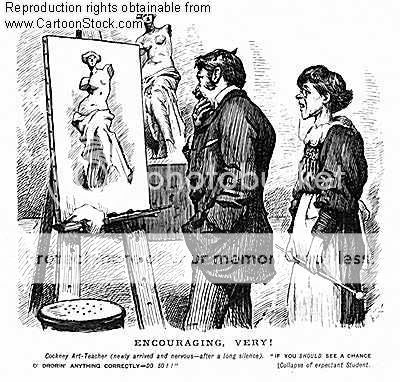 "No Art Director Ever Asked To See My Diploma"
"No Art Director Ever Asked To See My Diploma"Article by: Daniel Pelavin
The education of many a successful illustrator takes place quite handily outside the bounds of any certified program or academic course of study. The most important, perhaps only credentials of any significance in this field are the portfolio. While a portfolio of student samples may be quite handsome in presentation, it is rarely an accurate indicator of one's ability to effectively solve actual problems, under true deadlines while the exigencies of real life intervene. It is no wonder that school work is quickly purged and replaced by assignment work as soon as possible in the portfolios of those fortunate few to get work. If the ultimate goal is to distance oneself from all traces of "school," something more than a diploma must be offered to those who intend to work in the field rather than simply go back into teaching.
An honest appraisal of the odds might be a good place to begin. Although it might not be the biggest boon to enrollment, letting people know just how competitive the field of illustration is would certainly help sort out those who potentially have other or better options. Illustration as a career is most successfully pursued by those to whom no other option is acceptable. It takes that kind of motivation to overcome the inevitable and constant stream of obstacles. Some frankness about the nature of the illustration market and the people an illustrator will have to work for would go a long way in discouraging all but the most foolhardy and desperate from pursuing this glamorous and enviable career.
Every illustration student should know that even the most brilliant art director, say one who can dial an entire phone number including area code without having to look it up again, actually believes he could do your job if he wasn't so busy. While fostering the ideal of creativity, perhaps we could also foster the reality everybody remotely involved with your illustration feels perfectly comfortable taking credit for it.
This next item may seem like a very odd notion for institutions of higher learning but, how about showing some respect for students and some recognition for what they already know. Rarely will a nascent illustrator have arrived at college age without already having worn out his share of pencils. Don't treat him like he just hatched and for heaven's sake do your share to put an end to this myth of "artistic talent" which fosters such deep contempt among the lay public for those "gifted" souls who appear to have it so easy. True artistic talent is the ability to pursue your goals and not give up until you succeed, whether it is on the second or seventieth try.
 "The Poor Poet" by Carl Spitzweg (1808 - 1885) Click the image to learn more about the hidden symbolisms that depicts the so-called "Starving Artist"
"The Poor Poet" by Carl Spitzweg (1808 - 1885) Click the image to learn more about the hidden symbolisms that depicts the so-called "Starving Artist"While we accept that most people can be more or less literate with enough effort, we are still rather behind in recognizing that the same thing applies to visual expression. A little less emphasis on inspiration and more on perspiration would seem to apply here. While it seems that working illustrators would be the obvious choice as illustration teachers, the axiom "those who can do and those who can't teach" may have actually been invented in the illustration field. Rarely do you find an illustrator who actually has teaching skills, can find the time and regards students as more than just potential studio interns. All too frequently what you get are semi-illustrators with too much time between jobs and underfed egos.
 This image was taken from popular art blogger/critic Irene Gallo regarding one the 2007 Annual Scholarship Competition
This image was taken from popular art blogger/critic Irene Gallo regarding one the 2007 Annual Scholarship Competition The gruesome result of this ill-advised practice is the annual scholarship competition, where we honor the "best and brightest" for their pitiful imitations of illustration styles of the past. The crowning irony of this grotesque spectacle is the mention of these instructors in the exhibition credits, ostensibly, I guess for doing such a laudable job of helping students deny their own individuality. The next generation of great illustrators will come into being despite this circus but, it would be far less degrading if we didn't treat them like little monkeys.
Imitation may be the sincerest form of flattery but, ethics aside, it is primarily the province of bottom feeders in the illustration field. Give a student the ability to imitate Bernie Fuchs and you've given him a good shot at the CA Illustration Annual for 1974, give him skills to negotiate, promote and run a business, and he may actually be able to make a living. Enough with this baloney about oil washes and techniques of the "great masters."
 There is a great deal to learn from the history of illustration but, it ought not be confused with technique. True style comes from within not from copying someone else. It is not disposable nor a fad of the moment, ie. the fashion industry.
There is a great deal to learn from the history of illustration but, it ought not be confused with technique. True style comes from within not from copying someone else. It is not disposable nor a fad of the moment, ie. the fashion industry.A good device for remembering what's really important here is the three "D's," drawing , drawing and drawing. Drawing from life, drawing from memory and drawing from inspiration are good. Tracing over photographs doesn't quite get it and plays you right into the hands of those who have no respect for honest effort in the first place. Illustration is a business, not to be confused with fine art, which is also a business (only a much more complicated and ugly one.) Those who commission illustration aren't "benefactors of the arts," they are skilled negotiators with a clear vision of the bottom line.
An understanding of usage, rights and how to determine fees does not hamper creativity, it gives an illustrator the freedom to be creative. Techniques in marketing and promotion change and evolve as quickly as illustration styles. You haven't taught promotion by telling students to send postcards. Ask any art buyer how many postcards he receives daily, before you suggest that direct mail even gets noticed any more.
If you don't recognize illustration as a business and concentrate on the required skills, you are shortchanging those foolhardy enough to believe in you and after all, they don't really need that diploma to get assignments any more than Dumbo needed his lucky feather to fly.
My question:
Do you agree with this article?










This is one of the best way to settle things.
artist